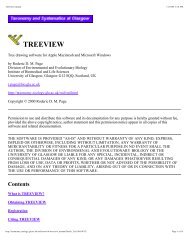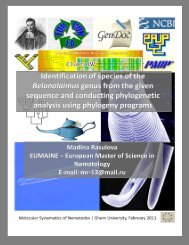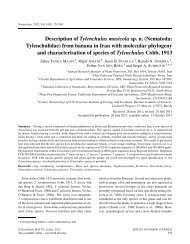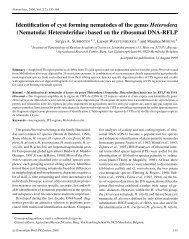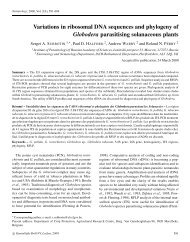Morphological and molecular characterisation of Californian species ...
Morphological and molecular characterisation of Californian species ...
Morphological and molecular characterisation of Californian species ...
Create successful ePaper yourself
Turn your PDF publications into a flip-book with our unique Google optimized e-Paper software.
Studies on Metaporcelaimus<br />
with narrowly rounded tip, length ranging from 28 to<br />
70 μm, always longer than anal/cloacal diam. (c ′ = 1.1-<br />
2.0), <strong>and</strong> occupying 1.7-4.3% <strong>of</strong> total body length. The<br />
cuticle is typical dorylaimid <strong>and</strong> its inner core ends near<br />
the tail tip.<br />
As currently defined, therefore, Metaporcelaimus <strong>and</strong><br />
Aporcelaimellus are not distinguishable on the base <strong>of</strong><br />
their caudal region. Nevertheless, conical-tailed <strong>species</strong> <strong>of</strong><br />
Aporcelaimellus resemble members <strong>of</strong> Metaporcelaimus<br />
rather than the other, rounded-tailed, forms <strong>of</strong> Aporcelaimellus.<br />
Frequency <strong>of</strong> males<br />
The taxonomic interest <strong>of</strong> this character in separating<br />
generic taxa is questionable <strong>and</strong> does not deserve too<br />
much attention. However, a simple compilation <strong>of</strong> available<br />
data shows that in 42% <strong>of</strong> Metaporcelaimus <strong>species</strong><br />
(5 out <strong>of</strong> 12) the male is known, <strong>and</strong> that this percentage<br />
is 35% in Aporcelaimellus (17 out <strong>of</strong> 49).<br />
Shape <strong>of</strong> spicules<br />
The description <strong>of</strong> these structures is <strong>of</strong>ten reduced<br />
to morphometrics, a mention <strong>of</strong> curvature <strong>and</strong> a usually<br />
less detailed illustration. A simple comparative analysis<br />
<strong>of</strong> their morphometrics reveals no significant difference<br />
between the genera. For instance, in Metaporcelaimus<br />
the spicules are variably slender, 4.1-6.6 times as long<br />
as wide, very similar to those found in Aporcelaimellus<br />
(range 4.2 to 6.3).<br />
General conclusions<br />
The results <strong>of</strong> our analysis show that, as currently defined,<br />
it is impossible to find reliable morphological differences<br />
between Aporcelaimellus <strong>and</strong> Metaporcelaimus,<br />
<strong>and</strong> that the ranges <strong>of</strong> their most relevant morphometrics<br />
widely overlap. Nevertheless, two characters, namely the<br />
nature <strong>of</strong> cuticle <strong>and</strong> the morphology <strong>of</strong> the caudal region,<br />
might have diagnostic value since Aporcelaimellus<br />
<strong>species</strong> can be divided into two groups, one <strong>of</strong> them quite<br />
close to Metaporcelaimus forms <strong>and</strong> therefore probably<br />
belonging there.<br />
Molecular <strong>characterisation</strong> <strong>of</strong> <strong>Californian</strong> <strong>species</strong><br />
<strong>and</strong> Aporcelaimidae phylogeny<br />
Four sequences were obtained in the present study<br />
(Fig. 6): one for M. capitatus, one for M. marinensis sp.<br />
n. <strong>and</strong> two for M. ovogranulosus sp. n. The sequence<br />
lengths ranged from 760 to 770 bp. The two sequences<br />
<strong>of</strong> M. ovogranulosus sp. n. were nearly identical <strong>and</strong><br />
differed in one nucleotide only (similarity 99%), while<br />
their similarity to M. capitatus was 81% <strong>and</strong> that <strong>of</strong><br />
M. marinensis sp. n. was 79%. The sequence similarity<br />
among M. capitatus <strong>and</strong> M. marinensis sp. n. was 76%.<br />
Unfortunately, no sequence <strong>of</strong> any Metaporcelaimus<br />
representative was available in GenBank, <strong>and</strong> for the<br />
phylogenetic analysis sequences <strong>of</strong> other aporcelaims <strong>of</strong><br />
the genera Aporcelaimellus, Aporcella <strong>and</strong> Sectonema, as<br />
well as representatives <strong>of</strong> other dorylaimid families were<br />
included. The evolutionary relationships as inferred from<br />
the analysis <strong>of</strong> the D2-D3 expansion segments <strong>of</strong> the LSU<br />
rDNA gene are presented in Figure 7.<br />
Metaporcelaimus sequences form part <strong>of</strong> a highly supported<br />
branching <strong>of</strong> the <strong>molecular</strong> tree where they clustered<br />
together with members <strong>of</strong> Sectonema. Nevertheless,<br />
it is relevant that the four Metaporcelaimus sequences<br />
are divided into two highly supported subclades, since<br />
M. marinensis sp. n. appears more related to Sectonema<br />
sequences than to other Metaporcelaimus, a result that<br />
should be interpreted with caution due to the significant<br />
morphological differences observed between the two genera.<br />
The most relevant result <strong>of</strong> the <strong>molecular</strong> tree was the<br />
positioning <strong>of</strong> aporcelaims, which were distinctly separated<br />
<strong>and</strong> distributed within three major clades. The first<br />
major clade included Metaporcelaimus <strong>and</strong> Sectonema<br />
which clustered together <strong>and</strong> formed part <strong>of</strong> a larger<br />
clade with representatives <strong>of</strong> the Qudsianematidae Jairajpuri,<br />
1965 (Crassolabium, Eudorylaimus, Epidorylaimus<br />
<strong>and</strong> Microdorylaimus) <strong>and</strong> Nordiidae Jairajpuri & Siddiqi,<br />
1964 (Enchodelus, Longidorella <strong>and</strong> Pungentus) as<br />
well as one member <strong>of</strong> Dorylaimidae (Prodorylaimus).<br />
The second clade <strong>of</strong> Aporcelaimidae included Aporcella<br />
simplex, the only representative <strong>of</strong> this genus in the tree,<br />
which was grouped together with discolaims (cf., Álvarez-<br />
Ortega et al., 2013). The third clade <strong>of</strong> Aporcelaimidae<br />
included Aporcelaimellus representatives <strong>and</strong> formed part<br />
<strong>of</strong> a large group dominated by long-tailed taxa <strong>of</strong> assorted<br />
taxonomic affiliation. This phylogenetic analysis matches<br />
the results <strong>of</strong> previous studies (see Holterman et al., 2008;<br />
Álvarez-Ortega & Peña-Santiago, 2012; Álvarez-Ortega<br />
et al., 2013) <strong>and</strong> provides evidence that the current taxonomic<br />
system for dorylaims, especially Dorylaimina, does<br />
not reflect the phylogeny <strong>of</strong> this group <strong>and</strong> should therefore<br />
be revised.<br />
Regarding the taxonomy <strong>of</strong> aporcelaims, <strong>molecular</strong><br />
data support the hypothesis that Aporcelaimellus, Aporcella<br />
<strong>and</strong> Metaporcelaimus are three valid genera. How-<br />
Vol. 00(0), 2012 15



